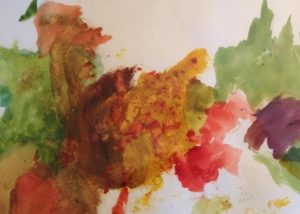By Raquel Chapin Stephenson, Ph.D., ATR-BC, LCAT | November 25, 2015 | Health Care
William Utermohlen, a professional artist, recorded his cognitive decline through self-portraiture (Grady, 2006). Incredibly brave and astute, his visual representation of the journey into Alzheimer’s Disease reveals an increasingly fragmented ability to organize the world outside, the darkening of life around him – an increasingly frightening picture. For Utermohlen, expressing his sadness through his art was a way of staying connected with the outside world. Like Utermohlen, individuals who have dementia still have a great need to communicate with others (Stephenson, 2015).
Communication and expression, like eating and sleeping, are basic human needs. When a person loses the ability to process language and words become an impossible tool for communication, that person is at greater risk for becoming socially isolated or lonely. Social isolation often leads to depression, further comorbid medical problems, and deeper reliance on the healthcare system. Despite the loss of verbal communication, however, a person still retains the capacity to express thoughts and feelings. The visual nature of art allows individuals to bypass the exchange of words. Color, texture, line, shape, and form elicit a visceral response and can be responded to within the pictorial “language.”
When understood as an alternative language, art making can be a powerful way to support the abilities and qualities an older person does have, including life experience, wisdom, and enhanced ability to solve nuanced problems. In this way, art therapy can have a significant impact on reducing isolation and loneliness, as new windows of communication may replace verbal methods shut down by dementia. By connecting with people who have Alzheimer’s Disease or dementia through their expressions in art, along with other small, nuanced forms of non-verbal communication, we are able to find new avenues of communication (Stephenson, 2015).

Lila Watercolor 12×18 inches
An older adult with dementia may not be able to execute a thematic painting or drawing, but the visceral qualities of art materials can still evoke emotional responses, where the individual expresses feelings through visual expression. Lila, a 90-year-old woman debilitated by arthritis and late stage Alzheimer’s Disease, could no longer speak English, her second language, and instead spoke Russian, her mother tongue. She had become isolated, with the loss of memory, language, and subsequently the ability for others to relate to her. Lila’s disease prevented her from communicating with others in the way she used to be able to. Had we given Lila a set of instructions to follow, she would not have been able to follow them. So much of our lives are dictated by instructions. How confusing the world must seem, then, to a person with significant dementia who cannot understand instructions.
Lost in a world with words she could no longer comprehend, Lila came alive when art materials were placed in front of her. Painting for Lila was a full experience in which she would hold and use paint brushes in both of her hands. Sometimes, she painted only with her fingers, taking great pleasure in the feeling of the paint as she massaged the thick, textured watercolor paper. Her eyes sparkled with pride as her painting came into being, and she reveled in the colors that reflected back at her, as well as the accolades she received from peers and caregivers. Lila was unable to paint a thematic picture; she had lost the ability for abstract thought. However, her engagement in art making provided evidence of her effort and desire to connect with those around her, utilizing her strengths and developing alternate pathways of expression through visual art (Stephenson, 2015).
Research is beginning to tell us that we can reduce social isolation through participation in creative activities (Cohen, 2006). What if art therapy could prevent or at least delay social isolation and loneliness by helping a person, like Lila, to stay connected to others despite loss of verbal abilities? Our field has the great opportunity to demonstrate not only how art therapy can help to reduce social isolation and loneliness and promote wellbeing, but also how that improvement in wellbeing can be a highly cost effective way to delay an older person’s significant reliance on healthcare, thereby reducing societal costs on a large scale. We need to pinpoint the efficacy of art therapy programs and evaluate cost-effectiveness of participation to promote widespread implementation of art therapy.
References:
Cohen, G. D., Perlstein, S., Chapline, J., Kelly, J., Firth, K. M., & Simmens, S. (2006). The impact of professionally conducted cultural programs on the physical health, mental health, and social functioning of older adults. The Gerontologist, 46(6), 726-734.
Grady, D. (2006, October 24). Self-Portraits chronicle a descent into Alzheimer’s. New York Times. Retrieved from http://www.nytimes.com/2006/10/24/health/24alzh.html?_r=0
Stephenson, R.C. (2015). Color my words: How art therapy creates new pathways of communication. In L. Carozza (Ed.) Communication and aging: Creative approaches to improving the quality of life (pp. 247-267). San Diego, CA: Plural Publishing, Inc.
